
Are there 100,000,000 creationists in the USA?
By James Riley

In June, 2019, Gallup released their most recent poll of public attitudes on evolution and creation in the USA. According to their survey, 40% of the sampled US population were creationists. That is, when asked: “Which of the following statements comes closest to your views on the origin and development of human beings?” 40% of respondents selected: “God created human beings pretty much in their present form at one time within the last 10,000 years or so.”
So to be more specific, the 40% figure isn’t just for creationists, but rather young-earth creationists (YECs)—those who reject both evolution as a process and that life has been around for billions of years. If we apply the Gallup percentage to the overall US adult population, we get a figure of 101,552,772 YECs (1).
Gallup’s polling of creationists at roughly 40% in the US has been relatively stable over the last few decades. As can be seen in Figure 1, since 1983 the percentage has fluctuated between 38% and 47%.
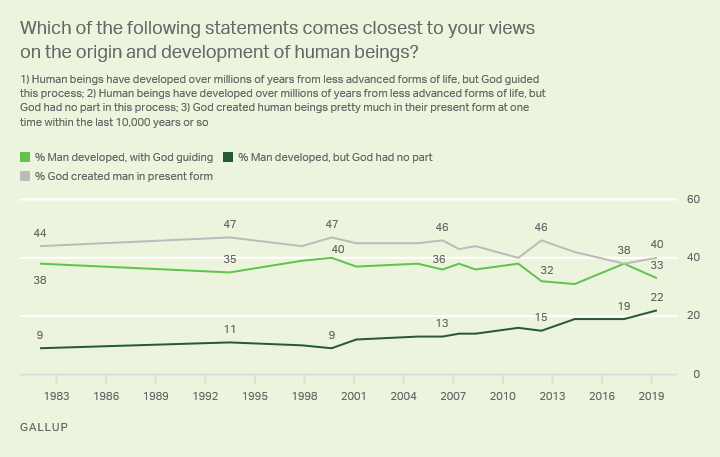
Yet, there are problems with accepting such numbers uncritically. These types of survey measures are OK at giving insights into general trends of beliefs or dispositions, but for telling us what people actually believe, they don’t hold up so well. How we ask questions about evolution, God, and creation, can radically alter the number of creationists generated by a survey—perhaps more accurately called ‘survey creationists’. In this article, I explore some conceptual issues involved in measuring attitudes to evolution and creation, and the problems arising from taking results at face value.
Blunt instruments and the issue of God
We have seen that Gallup’s recent poll produced an estimate of 101.5 million US adult YECs, however, by delving deeper we will see that the structure of the question really matters. As researchers at Pew have noted, branching questions about human origins generate different results than single question approaches. Looking at the left-hand side of Figure 2 below (which uses 2018 data) we can see that in Pew’s Two-Step Approach, people are initially asked if: (a) humans have evolved, or (b) have always existed in their present form; and then if respondents choose the evolution option, they are subsequently asked about God’s role in that process. Using this Two-Step Approach, only 31% of Pew’s US sample went on to select the creationist option. Alternatively, when asked about their views in a Single-Question Approach (the right-hand side of Figure 2), including whether evolution has happened and God’s role in that process, 18% selected the creationist option. A discrepancy of 13% just by changing the structure of the question in relation to God’s role.
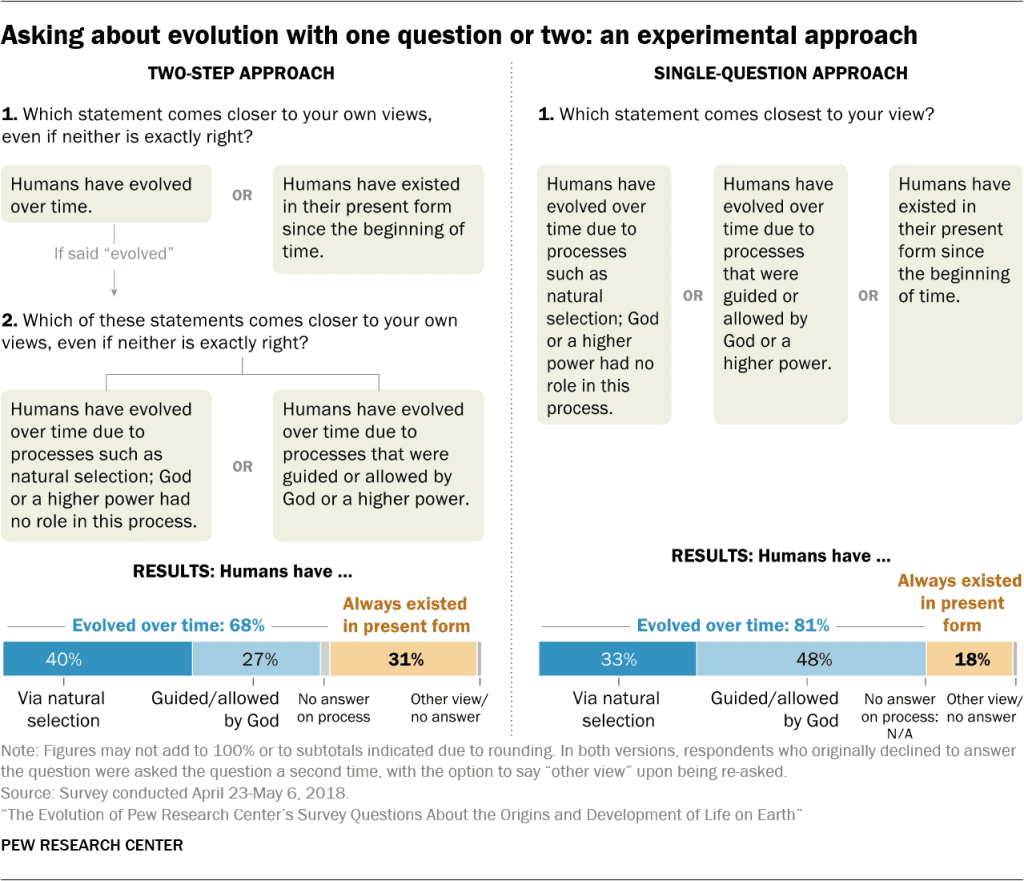
The difference between Pew’s Two-Step approach and the Single-Question approach suggests that when answering such questions, individuals are in part signalling something about their identity, not simply stating a rigid belief. The Two-Step approach (on the left side of Figure 2) makes no mention of God in the first stage of the question—“Humans have evolved over time”—potentially making religious individuals who see this as an atheistic option lean towards the creationist option as a way of defending or signalling their religious identity.
Note that the Pew polls produced lower figures of creationists (31% and 18%) than the Gallup poll above (40%). I would argue, given the salient nature of evolution-creation debates in the US, the inclusion of the word “God” in the question wording is acting as an ‘attractor’ for people who wish to signal their religious identity and indicate their belief in God’s role in creation. Pew’s Single-Question blunt measure of creationism makes no mention of God, only that: “Humans have existed in their present form since the beginning of time”, while their theistic evolution option does mention God. Therefore, people wishing to signal their belief in God’s role in creation may be more likely to choose the option which grants God creative agency. This perhaps explains the lower figure of creationists in Pew vs Gallup’s measures (and Pew’s higher level of Theistic Evolutionists), as Gallup’s creationist option explicitly states God’s role, while Pew’s doesn’t.
Another point to note on the differences between Pew and Gallup’s measures is that Gallup specifies a timescale for creationism (“…within the last 10,000 yeas or so”) whilst Pew does not specify a timescale (“…in their present form since the beginning of time”). So, in addition to the absence of God’s agency in creation, we could speculatively interpret the lower levels of creationists found in Pew’s poll as a result of YECs not being happy that a young age for the earth is not specified. However, the lack of respondents (<1%) selecting the option “Another view” cautions against this interpretation, but the results do not allow us to conduct such a fine-grained analysis. This is the very problem with these types of measures, which we will call from here on ‘blunt measures’. Whilst able to give us a sense of trends over time, we should be wary of looking at these percentages in isolation. These blunt measures bundle groups of propositions and assumptions into three neatly demarcated, idealised belief positions. Indeed, these idealised versions may not actually resonate with the population at large.
To reinforce this point, it’s time for some more back of the envelope calculations. Above I mentioned that extrapolating Gallup’s recent poll results to the US adult population produces a figure of 101.5 million young-earth creationists in the USA (40%). Pew’s Two-Step Approach, which returned 31% creationists, would give a figure of 78,703,398 adult creationists in the USA. Using Pew’s Single-Question Approach measure, with 18% selecting the creationist option, gives us a total of 45,698,747 adult creationists. The difference between Gallup’s figure and Pew’s lowest figure is roughly 56 million people—slightly more than the total state populations of Florida, New York, and Pennsylvania combined. That is a lot of missing creationists.
We must acknowledge that the numbers of creationists produced by a survey is contingent upon factors such as wording and structure, and thus, in some way must differ from the number of actual creationists in a given country.
Sharper measures, sharper results?
There are deeper issues with these survey measures, beyond the way in which one includes God in the question. Let’s take a deeper look at what these blunt measures of attitudes mean, and what they assume of the individuals choosing them.
Going back to the Gallup 2019 poll, which produced the 40% YEC figure, we can see there are three distinct options:
- God created human beings pretty much in their present form at one time within the last 10,000 years or so;
- Human beings have developed over millions of years from less advanced forms of life, but God guided this process;
- Human beings have developed over millions of years from less advanced forms of life, but God had no part in this process.
Position (1) is easily identified as YEC, given that it denies both evolutionary change and the length of time humans have been on the planet. However, positions (2) and (3) are sometimes labelled theistic evolution and atheistic evolution. This is a problem, as Gallup’s data highlights (Figure 3) that there are people who identify with a religion in all three of these categories. Conversely, 22% of individuals who selected position (2) ‘God-guided evolution’, and 14% of individuals who opted for option (1) ‘YEC’, had no religion. So rather than thinking of options (2) and (3) as theistic and atheistic evolution, I think it better to understand them as theistic and naturalistic versions of evolution.
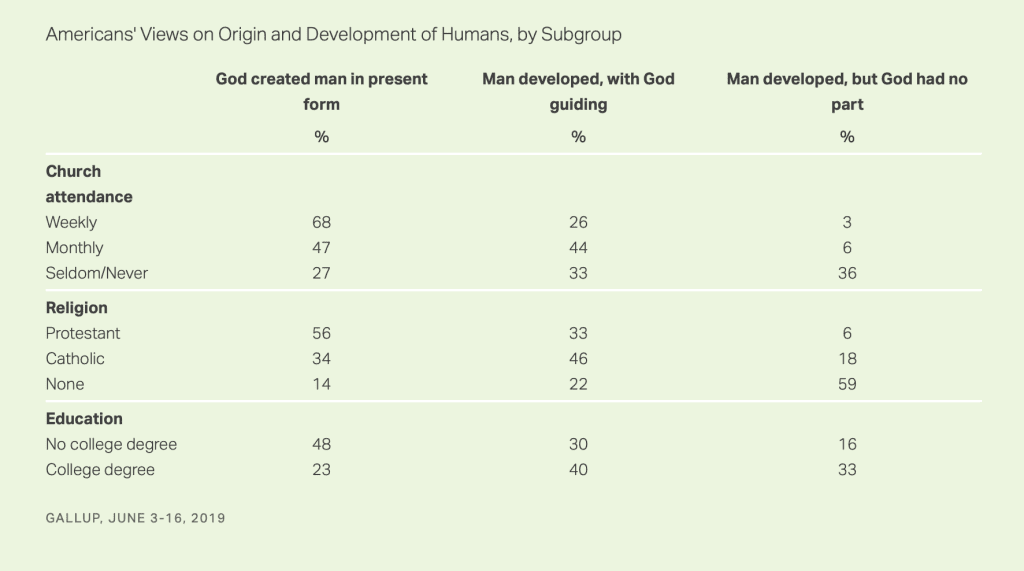
As mentioned above, an issue with these measures is that they combine numerous propositions into idealised meta-categories of belief positions. For example, Gallup’s YEC option states: “(1) God created human beings pretty much in their present form at one time within the last 10,000 years or so.” To select this option, it would seem the individual believes that “God created humans,” “the human species has never changed,” and “creation happened quite recently”. The single measure bundles all these propositions, and allows no nuance of beliefs to emerge.
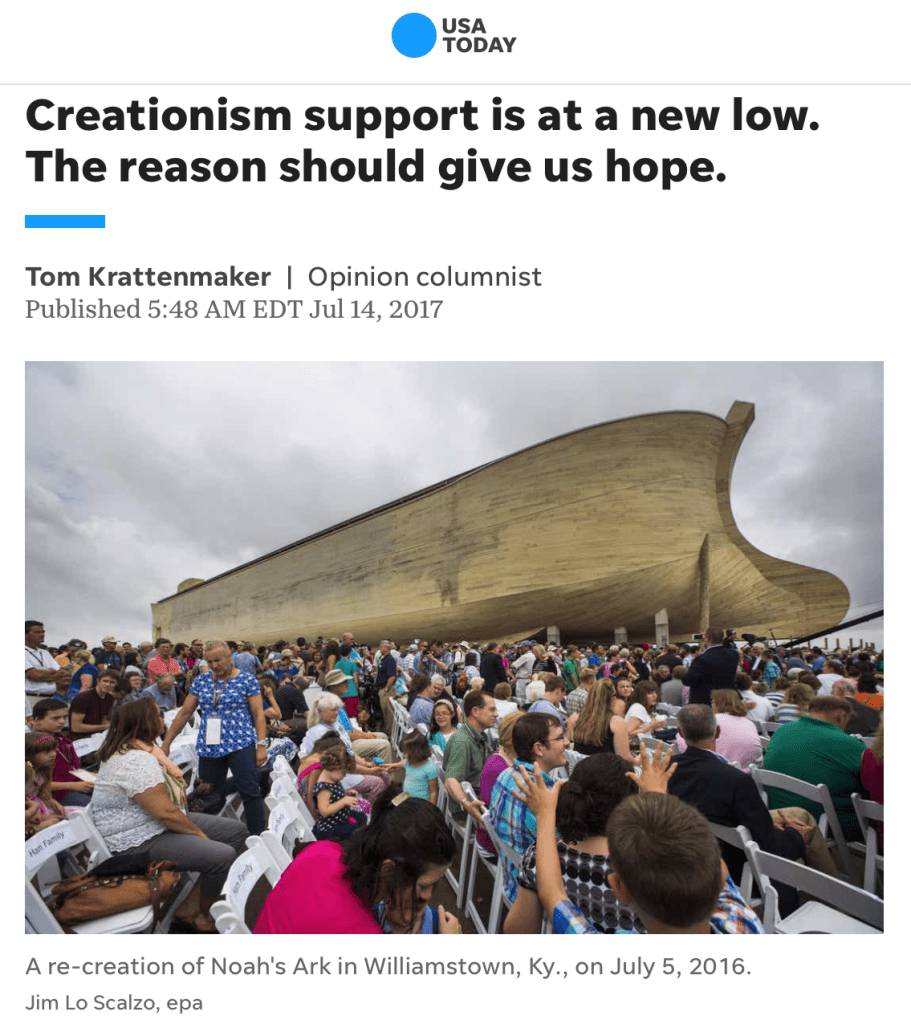
In addition to these generalised positions, when the purported percentage of creationists is picked up by the media, other (often Christian-centric) assumptions are made about these ‘survey creationists’. Assumptions, such as a belief in Adam and Eve; the co-existence of early humans and dinosaurs; or that creation happened over seven 24-hour days. In effect, media coverage often assigns these ‘survey creationists’ the same beliefs and fervour as high-profile professional creationists, such as Ken Ham. An example of this can be seen in this article from USA Today, which uses Gallup survey results to contextualise a news story about a creationist protest against the erection of a statue of Clarence Darrow, the pro-evolution adversary in Dayton’s historic Scopes Monkey Trial of 1925. The newspaper article also contains a picture of Ken Ham’s recreation of Noah’s Ark.
Ken Ham is an archetypal evangelical YEC, who clearly has a formalised worldview he believes in with certainty. His organisation, ‘Answers in Genesis’, sets out the basic tenets of their creationist worldview as follows:
God created “the heavens and the earth” fully-formed and functioning in six days, 6,000 years ago, at around 4004 BC. The context of Genesis 1, as well as other places in Scripture, make it clear these days were ordinary, 24-hour days. God’s original creation was perfect, with no death or suffering.
Answers in Genesis
In the USA Today news story, the juxtaposition of Ken Ham’s Ark and the creationist protest against the Clarence Darrow statue, with the public opinion poll of ‘survey creationists’, leads one to assume we are dealing with the same ‘creationism’. A suggested parity between outspoken antievolutionist groups and the large percentage of ‘survey creationists’ who emerge from opinion polls is evident. Yet, do those individuals who tick the creationist option on a Gallup or Pew survey, really hold the same beliefs, with the same certainty and fervour, as an overtly political campaigner such as Ken Ham?
The Gallup and Pew blunt measures discussed so far assume people have formalised positions, held with certainty, which are neatly packaged and mutually exclusive. Over the last few years, however, there have been commendable efforts to build sharper measures of people’s beliefs. The quantitative sociologist Jonathan Hill has deconstructed the various components and propositions of an ideal-type of creationism, to better assess its actual prevalence in the US. In his 2014 study, instead of asking participants to select from three mutually exclusive narratives of origins, Hill asked various questions relating to the evolution of humans and God’s involvement and reconstructed the categories of ‘Creationism’, ‘Theistic Evolution’, and ‘Atheistic Evolution’. From the broadest definition of creationism, rejecting human evolution and belief in God’s involvement in the origins of humans, Hill found 37% of respondents could be classed as creationists. This figure is slightly lower than measures from Gallup, however, interestingly, Hill also allowed participants to say how certain of their beliefs they were—something not done in Gallup’s blunt measures. When only taking those who said they were ‘very’ or ‘absolutely’ certain of their views, this figure dropped to 29%.
Hill went one step further than just asking about participants’ beliefs about evolution and God, however, also asking participants about a range of beliefs which pertain to an idealised version of YEC, including that:
- humans did not evolve from other species;
- God was involved in the creation of humans;
- God created directly and miraculously;
- Adam and Eve were historical figures;
- the days of creation were literal twenty- four hour days;
- humans came into existence within the last 10,000 years. (Hill, 2014)
Taking only those who agreed with all six of the above propositions, Hill found that only 8% of the sampled US population could be considered YEC using this more restrictive definition. Hill remarks in his study that:
Many creationists are simply unsure whether the days of creation were literal, and they are especially unsure about when humans first came into existence. Many Americans will select a Young Earth creationist view when presented as a package with other beliefs they are more certain of, but not many are able to clearly affirm the full position when it is deconstructed into its components. (Hill, 2014: 9)
Using Hill’s figure of 8% of individuals who agree with all the propositions we may combine into an idealised version of YEC, as espoused by figureheads like Ken Ham, we can extrapolate a somewhat sharper estimate of levels of this type of YEC in the USA. Using this sharper measure of creationism, we get the number of 20,310,554 adult YECs in the US. A stark difference from the 101.5 million figure projected from Gallup’s recent survey that we started with—a difference roughly equal to the entire population of Germany.
Beliefs with certainty
When reading Gallup-style blunt measures, the neatly-demarcated positions and categorical figures produced can lead one to think of public attitudes on human origins as clear, neat and definite, however, blunt measures don’t tell us the certainty with which these views are held. In an attempt to better assess the beliefs of North Americans regarding God, evolution, and creation, sociologist Elaine Ecklund and colleagues developed a novel way of measuring public views. Instead of offering the public a blunt measure, with three mutually exclusive options (creationism, theistic evolution, naturalistic evolution), Ecklund offered the public six narratives relating to creation and evolution (Figure 5 below).
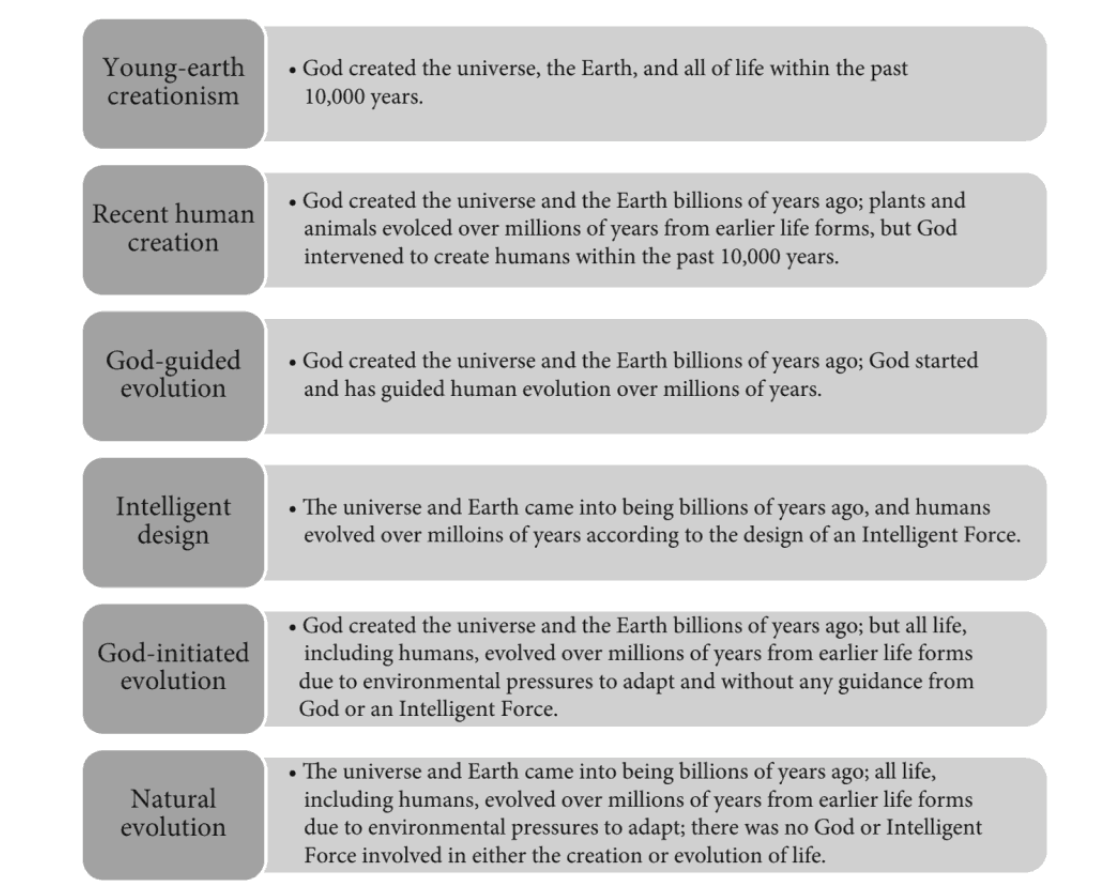
Yet, unlike in Gallup and Pew surveys where respondents must choose from only one of the three options, respondents to Ecklund et al.’s survey were allowed to select as many of the creation-evolution narratives as they wished. Furthermore, participants were asked to indicate to what extent they believed each narrative was ‘probably’ or ‘definitely’ true or false. This allowed the researchers to produce a far more detailed and flexible picture of attitudes to evolution and creation, than had previously been produced through rigid blunt measures.
What picture was found from this more innovative study of attitudes to evolution? Interestingly, uncertainty was the most popular response across the whole sample, with 57.5% of respondents saying that none of the six narratives was ‘definitely true’. Interestingly, 16% of all respondents said that more than one narrative was ‘definitely true’—highlighting that public attitudes don’t necessarily fit into the neat, exclusive categories of the researcher. This leaves 26.5% of the sample who said that only one of the narratives was ‘definitely true’. Of these individuals, creationism was the most popular narrative, with 43.3% of the 25.5% selecting this option. Thus, of all the respondents in Ecklund et al.’s study, 11% believed creationism to be solely and definitely true. Again, this marks a big difference from the headline-grabbing 40% with which we started this article. Doing some more quick maths, this 11% creationists figure gives us a total of 27,927,012 certain, true-believing creationists in the USA.
So what is the real figure? And what do these surveys tell us?
It can be alarming when we hear that 40% of the US population are YECs. It challenges much of what we believe about modern, scientifically advanced societies. It leads to speculations and assumptions: how could over 100 million Americans think Adam and Eve ran around with dinosaurs? However, I hope this brief overview of conceptual issues involved in measuring attitudes toward evolution has warned we should tread with caution when reading such figures, and be careful extrapolating the substance of people’s beliefs from such general numbers. The way in which questions are asked changes the amount of ‘survey creationists’ found. And while blunt measures are useful for tracking trends over time, we should not conflate this with a true figure of the number of creationists in a country. Indeed, none of the figures I have produced in this article, even those produced by sharper measures, should be seen as the correct figure in isolation. Beliefs, like people, are often ambiguous.
As sociologists Tom Kaden, Stephen Jones and Rebecca Catto have recently argued, continuing to measure public opinion using labels such as YEC and Intelligent Design, which large parts of the population don’t straightforwardly align with, may unintentionally result in legitimising groups whose central aim is public recognition for political ends, such as influence over education policy. More broadly, the continued uncritical acceptance of levels of ‘survey creationists’ serves to reinforce the agendas of explicitly anti-evolutionary advocacy groups, who, on the back of these figures appear more influential than they really are. This is not a criticism of Gallup or Pew, who are well aware of the difficulties of measuring attitudes in this area. Rather, it is a call to be aware that these polls indicate trends of dispositions, not absolute figures of the prevalence of formalised beliefs. If anything, the real discernible trend in American attitudes to evolution from these surveys is the rise of people choosing the naturalistic evolution option— which has more than doubled, from 9% in 1982 to 22% in 2019. So no, 100 million Americans are not YECs, but the uncritical reproduction of ‘survey creationist’ figures does help to bolster the legitimacy and arguments of the smaller proportion who are.

James Riley is a postdoctoral research fellow at the University of Birmingham.
Interested in the interrelationship between science and society, he has a background in science communication and the public understanding of science. Learn more by reading his Research Profile.
He can be found on Twitter: @JamesIRiley
References and Further Reading
Brenan, M. (2019) 40% of Americans Believe in Creationism, Gallup News, 26 July 2019.
Ecklund, E.H. and Scheitle, C.P. (2018) Religion vs. Science: What religious people really think. Oxford: Oxford University Press.
Elsdon-Baker, F. (2015) ‘Creating Creationists: The Influence of “issues Framing” on Our Understanding of Public Perceptions of Clash Narratives between Evolutionary Science and Belief’, Public Understanding of Science, 24(4): 422–439.
Hill, J. P. (2014). National study of religion and human origins. Grand Rapids, MI: BioLogos.
Kaden, T., Jones, S., Catto, R. (2019) ‘Language, Labels and Lived Identity in Debates about Science, Religion and Belief’, in Jones, S., Kaden, T., and Catto, R. (Eds) Science, Belief, and Society: International Perspectives on Religion, Non-Religion and the Public Understanding of Science. London: Brunel University Press, pp. 55-78.
Pew Research Center (2019) The Evolution of Pew Research Center’s Survey Questions About the Origins and Development of Life on Earth, 6 February 2019.
Unsworth, A. & Voas, D. (2018) Attitudes to evolution among Christians, Muslims and the Non-Religious in Britain: Differential effects of religious and educational factors. Public Understanding of Science, 27
(1) 76-93. 327,167,434 (total population) – 73,285,505 (Under 18s) = 253,881,929 (total adult population. 253,881,929 * 40% = 101,552,772 (creationists). Calculations are for adult population as only adults surveyed in opinion polls. Overall population figures from: https://www.census.gov/quickfacts/fact/table/US/PST045218. Note, population figures for all calculations in this article use 2018 figures. Thus, these quick calculations are meant to explore the conceptual point, not to make claims on absolute numbers of creationists.
